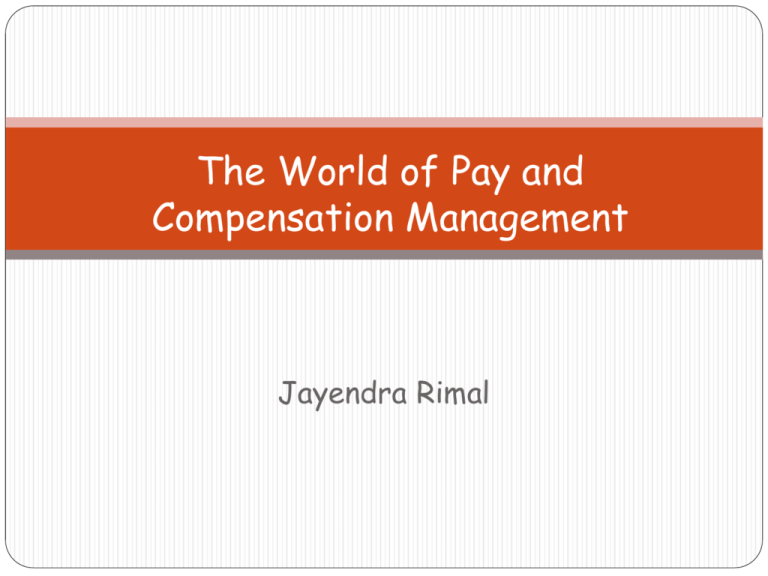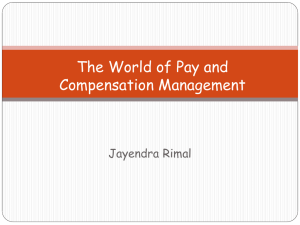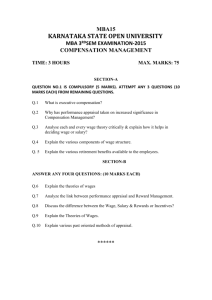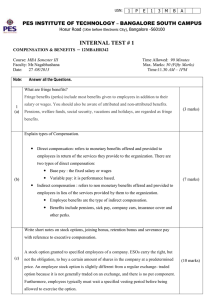The World of Pay and Compensation
advertisement

The World of Pay and Compensation Management Jayendra Rimal Introduction It was standard to allocate 40% of revenue for labor costs in the manufacturing industries. With a move towards automation, this figure has considerably come down. With more people employed by the service industry, (more than 70% employed by service-sector organizations in the US) the costs of the employee compensation can easily surpass 40% of the generated revenue. This would suggest that compensation needs to be managed with even more tenacity by organizations. The Compensation Program The major parts of a compensation program can be included in (i) Base Wages and Salaries (ii) Wage and Salary Add-ons (iii) Incentive Payments and (iv) Employees Benefits and Services. Base Wages and Salaries: Seen as the most critical component by employees as their lifestyles including the food, clothing, housing and other necessities are determined by the paycheck after taxes that they receive. Wage and Salary Add-Ons: This includes overtime pay, shift differentials, working on weekends/holidays, on call pay etc. For some type of companies these add-ons can be of permanent nature. The Compensation Program, Contd… Incentive Payments: This type of payment is usually given for a specified output. This is among the oldest of compensations also referred to as pay-for-output systems. This enabled individual activities to be monitored precisely, daily output measured and pay tied to the outputs. With the rise of the service sector in many countries this type of payment is neither feasible nor practical for many types of jobs. Benefits and Services: This includes time off with pay due to sickness, retirement, pay to dependants upon death of employee. Other would include company car, cafeteria services, tuition reimbursements, child and elder care and recreation. Efforts to limit the rising cost of benefits as there has been a increasing trend. Determining Rates of Pay How are decisions made that determines Mr. Anil Shah will be paid a hefty amount whereas another person with similar experience, expertise, competencies is paid much less? Some logical and rational reasons: 1. 2. 3. 4. 5. 6. 7. 8. 9. 10. 11. 12. 13. Kinds and levels of required knowledge and skills Kinds of business Union-nonunion status Capital intensive versus labor intensive Size of business Philosophy of management Total compensation management Geographic location Supply and demand of labor Profitability of the firm Employment stability Gender difference Employee tenure and performance Determining Rates of Pay, contd… 1. Kinds and levels of required knowledge and skills: In differentiating jobs for pay purposes, knowledge and skill required carries greatest significance. It seems that highly paid people have a common set of skills – their ability to influence others; mastered skills in a particular discipline helping them to reach eminence etc. 2. Kind of Business: Private sector jobs pay higher than public sector jobs all over the world. Rates of pay for lower level employees do not vary to the degree that rates of pay for top executives vary. But in Nepal it is true that the increase in pay by the government leads to pressure to raise pay for the private sector workers. 3. Union-Nonunion Status: Unionized organizations pay employees more in many countries. In Nepal unions resort to collective bargaining for higher pay. Determining Rates of Pay, contd… 4. Capital Intensive versus Labor Intensive Organizations that have low labor costs relative to revenue pay employees higher rates of pay. Labor casts has a great influence on profits. Labor intensive organizations require larger number of low skilled laborers. For capital intensive companies, using more sophisticated technology require less employees with higher levels of knowledge and skills resulting in the demand for higher pay. 5. Size of Business: Larger businesses provide higher wages than smaller ones. When products are in demand, come economies of scale and the opportunity to increase profits resulting in increased pay. 6. Philosophy of Management: Some organizations pay employees as much as possible while others have a bias about high pay. For others minimum wage laws and market established rates prevail. Some pay high end to attract and retain the pool of best available workers. Determining Rates of Pay, contd… 7. Total Compensation Package: What does the total compensation package involve? Supplemental wage packages include vacations, holidays, pensions, gratuity, insurances, overtime, profit sharing etc. But incentive plans are increasing the complexity of compensation packages. 8. Geographic Locations: When jobs disappear in certain areas, people move to locations where opportunities for jobs exists. Certain regions have historically paid employees higher wages than others. May be related to higher costs of living or per capita incomes. 9. Supply and Demand of Labor: During unemployment individuals with certain sets of skills or abilities are in demand. “Exotic” jobs with necessary skills can demand and receive premium wages. In essence the supply and demand has a direct bearing on the wage levels across industries. Determining Rates of Pay, contd… 10. Profitability of the Firm: Employees working in highly profitable firms have greater chances of receiving higher wages than lower earning firms. Why do some companies hire and retain best employees by paying them above average rates? 11. Employment Stability: Employees that seemingly have more permanent jobs are willing to work for less pay knowing that the pay check will come on time as long as they deliver. For example Government jobs 12. Gender Difference: Even now women earn less than men for doing similar jobs. This was more pronounced but lately the gap has narrowed. In companies where women are dominant the pay rates are lower than in companies where men are the dominant workforce 13. Employee Tenure and Performance: Usually as an employee’s pay increases with years of service but individual performance also is a determining factor. Companies note that senior employees are more dependable. Any questions?










